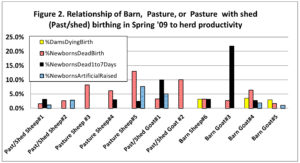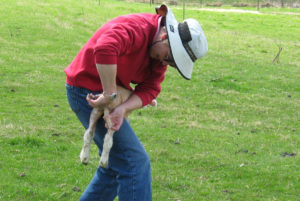Considerations for Pasture Lambing and Kidding
We associate spring time with newborn lambs and kids frolicking on green pastures. However, Northeast sheep and goats often give birth indoors in winter. This makes sense for farms targeting the Easter market for suckling lambs and kids or providing show prospects for the summer show circuit. If you do not sell to these early markets, then delaying and birthing outside in the spring when the grass is up may be perfect for you.
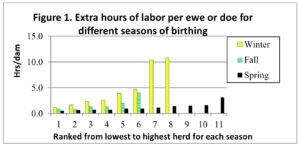
Figure 1
Approximately 30 Northeast sheep and goat farmers are participating in a Cornell project reviewing labor and feed costs for different birthing systems. To date, the project has uncovered some interesting results. Labor demands were substantially more for farms giving birth in Winter ’09 as compared to Spring or Fall (Figure 1). Furthermore, when comparing barn and pasture birthing in Spring ’09 (Figure 2), no pasture birthing farms lost dams at birth, although 3 of 4 barn birthing flocks had dams die. A huge benefit of pasture birthing is that dams can separate themselves and birth undisturbed leading to fewer dystocia or mothering issues. However, Goat Farm #3 experienced Floppy Kid Syndrome during birthing. If the same disease had occurred on pasture, kid losses might have increased because of difficulty treating collapsed kids.
Additionally, for Spring’09 birthing farms, feed costs for pasture-birthing goat herds averaged $6.80 per dam as compared to $21.74 for barn-kidding herds (most on pasture after 1 month) and $8.14 for pasture-birthing sheep flocks as compared to $42.86 for barn-lambing sheep flocks (most in barn through weaning). Dams that are limited to the barn for birthing consume harvested forage that could be reserved for winter feeding.
The success of pasture birthing is dependent on planning ahead for several factors.
Choosing a Birthing Pasture
Birthing checks can be done quickly (even with binoculars) if birthing pastures are close to the farm and dams are clearly marked ahead of time with spray paint. Thus, pastures bordering your barn or house are most convenient, especially if you anticipate returning triplet litters or “orphans” to the barn for more intensive rearing. Unfortunately these nearby pastures are often your winter loafing areas and by spring are heavily contaminated with manure and internal parasites. Many worms successfully overwinter outside (brown stomach worm, nemotodirus). Barber pole worm, our deadliest worm, does not survive outside in winter. It “hibernates” as immature larvae inside your sheep or goats. However, its dormancy breaks by early March and livestock then shed barber pole eggs in their feces. Therefore, you must plan ahead to insure that your livestock don’t access the proposed birthing paddocks over the winter.
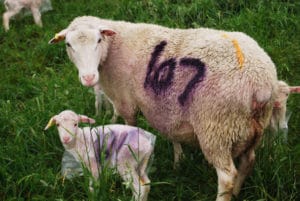
Plastic rain covers for lambs are not readily available in the US but can be handmade using plastic bread bags.
Article Definitions
Creep feeding – establishing a pen that offspring can get into but dams cannot so offspring can get extra feed to supplement dams’ milk, useful for triplets or offspring from low milk producing dams.
Dystocia – Labor difficulty due to malpresentation of the lambs/kids or large size in relationship to pelvic cage or dilation.
Grannying – the hormone-driven stealing of newborns by another dam as she goes into labor.
Jugs –small portable pens to temporarily put a dam and her litter in after birthing to facilitate bonding.
A second decision you need to make is whether to “set stock” or “drift lamb” during your birthing season. Most farmers in our study practice set stocking. Two weeks prior to lambing, one very experienced study farmer runs his flock through a working chute and spray paints them starting with the number 1. The first 40 ewes go in his first 5 acre birthing paddock, the next 40 in the next 5 acres, until all 300 ewes have been assigned a paddock. When lambs are born they receive the same spray paint number as their dam. Thus, for every lamb he can identify its paddock and dam. His system hinges on having plentiful grazing in each paddock to last the 6 week long birthing season. After lambing the flock is combined and rotationally grazed. Water should be centrally located in birthing pastures to discourage dams from having to travel far from their young to drink. Advantages of set stocking are that ewes pick out a nesting area and are undisturbed until they and their lambs decide to rejoin the flock.
In contrast, some study participants move their animals with temporary fencing every 1 to 5 days and must disrupt dams shortly after/during birth when it’s time to shift to the next grazing paddock. This can result in poor bonding between dams and offspring – leading to rejected offspring. Some farms have adopted drift lambing procedures where ewes that lamb during the 1 to 5 day period are left behind to form their own grazing unit to eventually combine with other “left behind” units. However, many farmers only have a few dams giving birth during a paddock move. These dams may panic if left behind. One option for smaller flocks is to move the temporary fence forward but let the “back” fence remain in place for at least one extra shift. Thus, dams that have recently given birth can stay in the previous grazing strip without being separated from the flock. You need good grazing in the previous strip so that hunger does not cause dams to move forward prematurely from their nesting site. However, letting grass get excessively tall can cause problems especially for breeds that hide their young, because dams may lose track of where they have stowed their offspring.
Planning for Inclement Weather, Mothering Issues and Predation
Weather patterns can change radically in spring time. Have a contingency plan to get animals to shelter in case of sudden snow storms or freezing rains. Many farms utilize hedgerows, woodlots, or dead drops during the birthing season. However, keep in mind that dams may mob shelters during bad weather. Any artificial shelters should be very open with wide entrances to try to avoid trampling of newborns. Grannying (stealing of newborn by another dam near parturition) may also occur when animals crowd together in bad weather. Plastic rain covers for lambs are not readily available in the US but can be handmade using plastic bread bags.
If your fence line is electrified, the metal corkscrew tie-out stakes for dogs are helpful to restrain dams with dystocia or hesitant to nurse young. Avoid setting up jugs in birthing pastures if possible because the whole flock may try to get to the feed in them and collapse the jugs onto newborns.
Several farms on our study experience no predation problems while others with similar fencing have problems with coyotes, foxes, or great horned owls. Dispose of stillbirths and uneaten afterbirths quickly so that local predators do not cultivate a taste for them. Some farmers prefer not to band tails for fear that discarded tails encourage predation. Most study farms with a history of predation successfully combat it with guardian dogs, llamas or donkeys and improved electric fencing. They still run into problems if dams are birthing in too large an area (i.e. 120 ewes on 25 acres) because one or two dogs are insufficient, especially if the terrain is hilly or forested. If predation challenges continue both night and day, some farms combine guardian species so that dogs patrol at night and llamas/donkeys take over during the day.
Handling Birthing Checks and Management Tasks
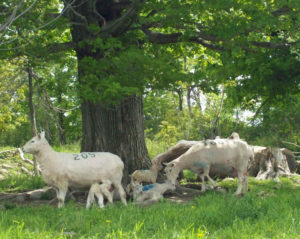
Birthing checks can be done quickly (even with binoculars) if birthing pastures are close to the farm and dams are clearly marked ahead of time with spray paint.
How often a farmer checks a birthing pasture depends on how difficult it is to catch newborns. Most kids are awkward on their feet for a couple of days after birth. This is not true for many breeds of sheep. Most sheep farmers doing pasture lambing try to conduct all their birthing tasks (spray painting, ear-tagging, tail docking, etc.) when they first spot a new litter. Be sure to catch the entire litter to avoid the dam taking off with some of her offspring. You’ll get good at holding several newborns between your knees. Catching can be done using a leg crook or fish net. You must desensitize dams toward this equipment prior to birthing.
You’ll need a good tote to carry your equipment cross country. Favorites include 5-gallon pails (good to sit on), carpenter belts, small coolers, and carpet bags (good for stowing an extra lamb). Wooden crooks help to traverse electrified fences. Banding is the most commonly used method for tail docking and castration as farmers have no access to electricity and want to avoid open wounds. However, some farmers delay docking until birthing is done and animals can be brought to an electrified barn. If you have a good quiet herding dog or are working with goats, newborns can be processed as 2 day olds when hardier.
Creep feeding to supplement dams’ milk is challenging on pastures because offspring want to follow their dams instead of congregating at a creep. Locate the creep near places where dams tend to lie down to chew their cud (near water, gates, or shade) to encourage offspring to explore it. Make sure the creep is well built so that the flock cannot collapse it.
Internal Parasites
Nursing dams and their suckling offspring are vulnerable to internal parasites especially when pasture conditions are warm and damp as in late spring and summer. Animals should be monitored frequently for anemia (FAMACHA scores and lethargy), diarrhea and poor body condition, and selectively dewormed as necessary. In temperate climates barber pole populations peak about 35 days after the egg laden manure is deposited on a pasture but drop substantially by 60 days. Highly susceptible animals should be moved out of a paddock within 5 days and not returned for greater than 60 days. The pasture may need to be brush hogged or grazed by a different species during the extended rest period to keep from getting too mature.
Pasture birthing is not for farmers who feel they’ll have too little control of birthing at a time when their labor and attention needs to be focused instead on hay or field crops. However, with wise advance planning, pasture birthing is a successful alternative for many farms to explore.


